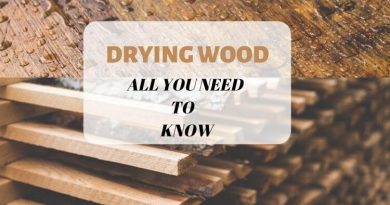How Much Wood is In a Cord [Quick & Easy Answer]
Wood is sold by the cord, but if you’ve never purchased wood before, you would possibly be wondering how much wood is in a cord.
If you’re buying a new home with a fireplace or are using home equity to place during a wood stove, you’ll soon be within the marketplace for some firewood, the firewood supply is typically sold during a measure called a cord.
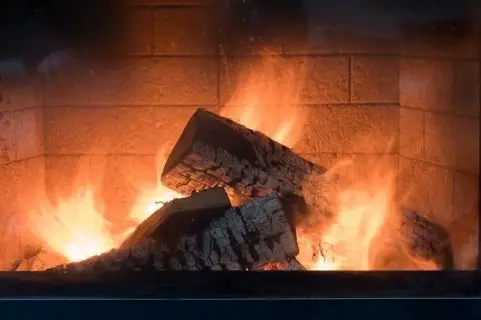
When it involves buying firewood supply the two most common ways to measure firewood is by the “Full Cord of Wood” or “Face Cord of Wood”.
There are other terms out-there, like face cord, stove cord or furnace cord are sometimes used to describe a stack of wood measuring 4 ft. high and 8 ft. long with a bit length shorter than 4 ft. A standard cord of wood length is 16 inches, or one-third of a full cord, but other lengths also are available.
Do you know the difference between each type of cord?
Do you know how to calculate the amount of wood to see how much wood is in a cord?
Don’t worry, in this article you will get the complete guide and a special bonus : A CORD OF FIREWOOD CALCULATOR!!!
When you don’t understand what that term means and are unsure of what to pay, buying wood can seem more daunting than, say, simply calling your local oil company for a fill-up.
First of all : What does a cord of wood means ?
Simple Explanation: A lot of firewood!
Complex Explanation: A cord is a the standard measurement for firewood, when it is stacked it measures approximately 4 feet high, 4 feet wide and 8 feet long and its total volume should be 128 cubic feet (3.5 cubic meters).
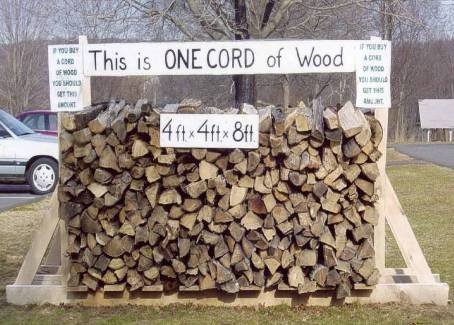
- Note that the exact amount of solid wood in a cord will vary based on the size of each piece and from supplier to supplier because wood is usually cut in various lengths, but most cords of firewood average 85 cubic feet (2.4 cubic meters) of solid wood. The remaining volume is taken up by air because of uneven stacking .
The difference between “Full Cord” and “Face Cord”
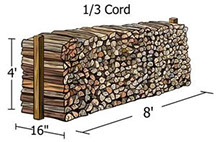
A face cord of firewood is up to one stack of firewood that measures four feet high by 8 feet long and is one-third as deep as a full cord. Despite the difference in volume, a face cord is usually casually mentioned as a cord.
When you’re shopping and comparing prices, confirm that the quotes you receive are for a full cord of wood. Log length during a face cord of firewood varies and there’s not a typical length.
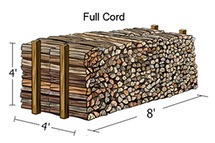
A full cord is a great amount of wood. It measures A cord measures 4-feet x 4-feet x 8-feet and features a volume of 128 cubic feet.
The entire length of the pile should be 8 feet (2.4 m), but the length of every piece of wood matches the width or depth of the pile and will average about 4 feet (1.2 m).
For example, the subsequent stacks of wood all equal one full cord:
- 2 rows of firewood 24” long , 2 feet high and 16 feet long
- 3 rows of firewood 16” long , 4 feet high and eight feet long
- 4 rows of firewood 12” long , 4 feet high and eight feet long
They all have a complete volume of 128 cubic feet (length x width x height).
Keep in mind you’re also paying for air space therefore the tighter the wood is stacked the more fuel you’re getting for your money.
TIPS before you buy a cord of wood
1. Firewood is usually not sold in a very neat stack from a wood yard you’ll visit face to face , but rather by the truckload, trailer-load, or another unit that’s difficult to convert to cost per cord. To still pay a good price per cord, consider the following:
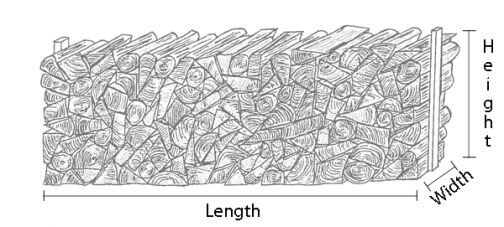
- Ask the seller for his or her estimate of how their volume compares to a cord measure, then determine the worth per cord.
- Stack the wood after delivery and compute your price per cord so you recognize for the longer term how this vendor’s unit of measure compares to a cord.
- If you want to buy the wood sight unseen, alert the seller that you simply are going to be available when the wood is delivered which you reserve the proper to refuse the acquisition .
- In some cases you’ll be willing to pay a better cost per cord for: a) Firewood move length or more finely split, representing a greater labor investment; b) Well-seasoned wood which burns more efficiently (see: Firewood Season: Tips for choosing & Storing Firewood); c) Delivery and stacking.
2. Verify the length and height of the wood pile. Take a tape measure or yardstick and measure the peak and length of the whole pile.
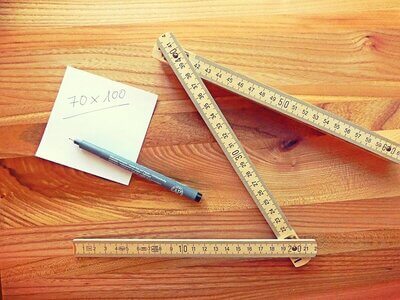
For both full cords and face cords, the length should be 8 feet (2.4 m) and therefore the height should be 4 feet (1.2 m).
The exact length and height can vary once you purchase a thrown cord, but you ought to still measure these dimensions and check them against the size listed by the dealer.
3.Types of wood
Not all wood is that the same. Some types make far better for firewood than others. Make certain you recognize what you’re buying when comparing prices.
Hardwoods are the simplest for home burning, because they burn slowly and typically emit little smoke and few sparks. These include:
- Ash
- Maple
- Black birch
- Oak
- Walnut
Here is an in-depth comparison between oak and mahogany! You will see the pros and cons of each one!
If you discover a cord of wood for a price that seems too good to be true, make certain to verify the sort of wood you’re buying in order that you don’t find yourself getting a cord of sentimental wood.
4. In order to avoid wasted space, insist that the wood is cut to burning length, split, and uniformly stacked during a pile.
Although this might increase the value of the wood for handling, it’ll ensure a far better volume of energy estimation and can make stacking for storage that much easier.
5. Another measure of the wood stack is a Sheldon wood cord, which varies in size and is often larger than a full cord of wood.
There are a few sellers who will also refer to their firewood by load capacity, so the goal here is for the buyer to know what they are paying for.
6. Since the name given to a wood cord can vary and also be confusing for both the buyer and the seller, it is always smart when buying firewood to confirm the size of the stack or the amount of firewood you buy. This will make it easier when comparing different firewood sellers to get the best deal.
Average cost of a cord of wood
Here’s what you need to know to get the best price. Moreover, since firewood is rarely sold by the full cord, there are certain considerations worth keeping in mind when you want to find the best value.
Calculate the complete cord of wood value.
If you’re buying a face cord of wood, divide the depth of a full cord by the piece length of the wood in your face cord.
Multiply this quotient by the worth of your face cord to see the value of the complete cord.
Cord costs vary across the country, but generally you’ll expect to pay between $120 and $180 for a cord of hardwood that’s split and seasoned.
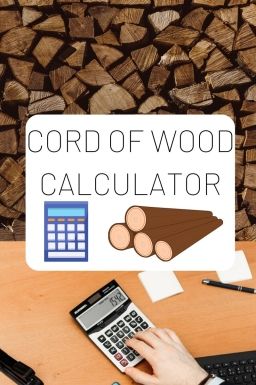
While this is often the typical cost, many consumers can expect to pay more, especially in winter. In some places within the U.S. costs are often as high as $220 to $400 per cord.
Doing some comparison-shopping in your area will offer you the simplest idea of what proportion you’ll expect to pay.
For instance, if the wood supplier is selling a face cord with an average piece length of 18 inches (45.72 cm) for $100, the calculation would look something like this:
48 inches (122 cm) / 18 inches (45.72 cm) = 2.66
2.66 * $100 = $266
The full cord value would be $266.
Keep in mind that the total cords dimension usually has the length of 4 feet (1.2 m) or 48 inches.
There’s tons of variables which will affect the value of firewood, including the following:
- Time of year (prices are higher in winter)
- Scarcity (prices are higher when there’s less wood)
- Region (your location can drive prices up or down)
- Whether the wood is dry (some charge more for dry wood)
- Type of wood (hardwoods can cost quite softwoods)
- Additional services charged by the vendor (delivery, stacking, etc.)
- For a full cord of mixed firewood, a standard range is $150-$250.
This means for a face cord, you’re usually watching $50-$80.
That should assist you as a start-point. Just keep in mind that the above variables can go up prices, and it’s possible for costs to go as high as $500 for a full cord ($175 for a face cord).
How much cord of wood do I need?
If you’re buying firewood to use in your fireplace, a cord of wood could be a bit overkill. Most of the people who use their fireplace a couple of times every week could be more happy with a face cord or 1 / 4 cord.
Our two preferred quantities are the 1/4 cord and 1/2 cord. It really depends on how cold it’s , and how often you prefer to sit down by the fire!
You’ve got bought an amount of firewood, you were told the quantity of wood you were paying for and getting was to be X amount.
You get the wood delivered and it’s typically dumped during a pile for you to stack.
Sound confusing? To create things easier we’ve created this cord of wood calculator to see what quantity firewood is contained within your stack of wood.
To use the cord of wood calculator simply enter the dimensions of your firewood stack into the suitable boxes and click on the Results!
How should I store and stack my cord of firewood?
So now that you’ve got bought and purchased your cord or cords of firewood and it has been dumped in your yard, (on an outsized tarp to save lots of cleanup), what does one do with it?
Storing and keeping the wood dry may be a hassle. Tarps can trap moisture, promote rot, and be difficult to get rid of after a snowfall.
And stacking the wood inside may be a poor choice, unless you enjoy the presence of insects and mice. The solution may be a simple firewood shed.
Luckily, there are plenty of DIY firewood shed plans, designs and concepts which will help you construct the perfect place to store your firewood.
The simplest way to cure firewood is to keep it dry and permit the air to undergo it.
This small firewood shed design will enable you to possess a dry supply wood all winter long.
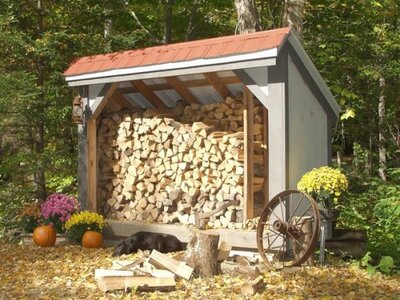
Here’s some tips for a lightweight, durable crossover.
While splitting your wood, try to split a whole piece into square pieces, this will make the end (stacking) much stronger than if round or parallel pieces are used.
In the long run, this saves time and effort. Otherwise, your wood pile may fall from weak ends.
If you stack more than one row, leave a good space between the rows for air circulation.
There is also no reason why we should stick to conventional row stacking; use your imagination and create something different, captivating and conversational.
A simple online search of firewood stacking will make interesting possibilities to consider.
How much cord of wood does a typical pickup truck hold?
The standard full sized pickup with a full box will hold a few half cord of wood if it’s stacked tightly.
If your supplier shows up with a pile of logs within the back of the truck facing every direction and says it is a cord of wood……stack it before you purchase it.

A small 1/4 to 1/2 ton pickup can haul about half a cord of firewood. Larger trucks and trucks with racks round the truck bed can haul one to 2 cords of wood.
However, it’s also important to think about the terminology that’s utilized in the important world.
If you’re buying firewood, then it’s really common for firewood sellers to call however much firewood they will pile during a truck a “face cord”.
That means that the particular amount of firewood will depend upon the dimensions of their truck, and the way they stack or pile the wood within the floor.
This is often usually just out of convenience, and not out of any ill intentions on the a part of the sellers.
Some wood dealers attempt to sell firewood from a pick-up truck.
Consumers should get on their guard, because a pick-up cannot hold a cord of firewood. An 8-foot floor can hold one-half of a cord while a 6-foot bed can barely hold one-third of a cord.
How long should wood sit before it’s able to be burned?
The sap in seasoned wood has dried up. Unseasoned, or green, wood won’t burn well (if at all) because it’s too wet.
If the wood is very heavy and has sap coming out of it, it’s too early to burn. Wood takes from 6 months to one year to dry, most wood being sold now was cut last spring.
To inform whether wood is seasoned, knock two logs together. Well-seasoned logs make a pointy ringing sound.
Well-dry logs will have cracked on the ends, not be reddish or golden in color and not have a woody smell.
It is recommended to burn only dry wood. Greenwood tends to create more smoke.
Keep this in mind as you gather firewood so that you can easily reach the driest wood. Also rotate the use and burn the oldest dry wood first to minimize rot.
How Much Cord of Wood Do I Need for Winter?
A full cord of wood typically lasts 6-10 weeks when used because the primary heat source for a range in the winter. Exactly how long wood will last depends on variety of things , and you must always be prepared with more wood than you expect to need.
6-10 weeks may be a reasonable range, but this will vary significantly counting on the sort of wood, the dimensions of the space, the quality of the insulation, and more.
If you’re preparing for winter, the last item you would like to try to to is to underestimate the quantity of wood you’ll need.
If you like it, share this content using one of the social media buttons below or comment and let me know what you thought.
RECOMMENDED READING:


